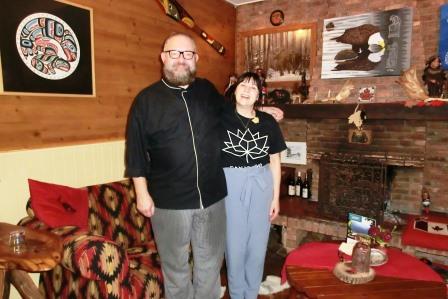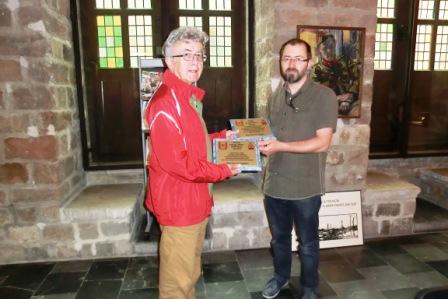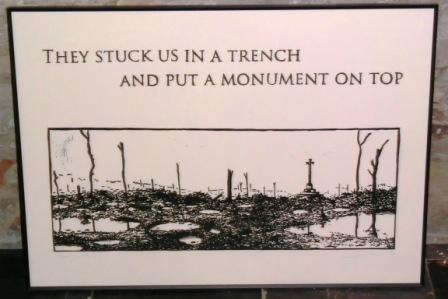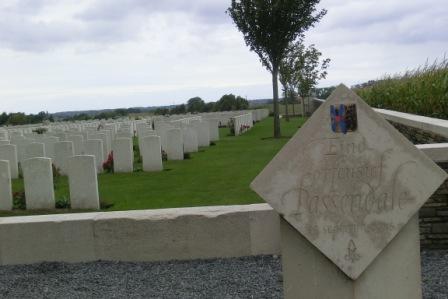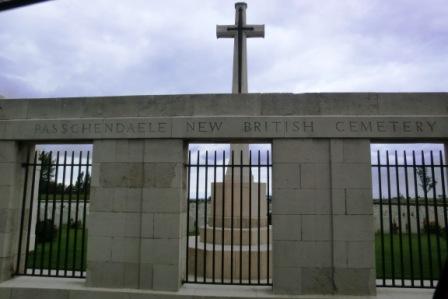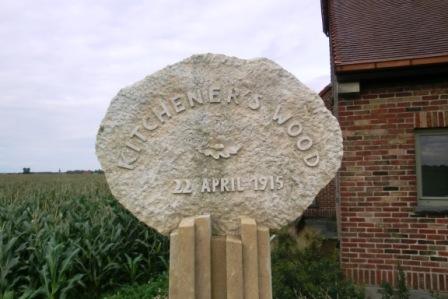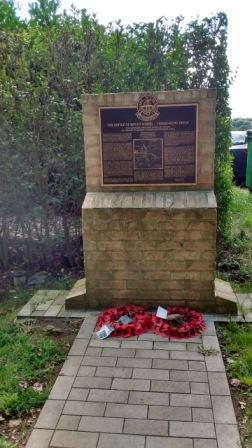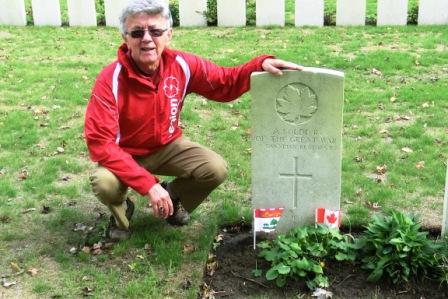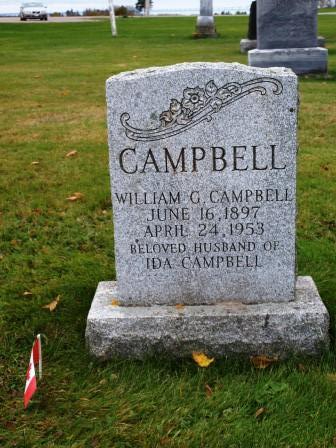December 30, 2017. During our first visit to the Canadian War Cemetery in Groesbeek in The Netherlands, we were able to place flags at the graves of three PEI soldiers buried there. In the last blog entry we told the story of George Preston SMITH of Kinkora, who was with the North Shore (New Brunswick) Regiment, and the accident in which he lost his life. (See On the War Memorial Trail ….. At The Canadian War Cemetery in Groesbeek)
Our thanks to Alice van Bekkum of the Faces to Graves Project, who shared an eye witness account that was recorded by Will Bird in his 1963 book about the North Shore (New Brunswick) Regiment. (See https://books.google.com/books/about North_Shore_New_Brunswick_Regiment.html?id=Iz7WAAAAMAAJ)

Excerpt about George Preston Smith from Will Bird’s book about The North Shore (New Brunswick) Regiment.
Before returning to place flags at the rest of the known soldiers from PEI, we stopped by a memorial marking the route on February 8, 1945 where soldiers marched into Germany on their way from Groesbeek, as part of Operation Veritable. This was the northern part of an Allied pincer movement that took place between February 8 and March 11, 1945 during the final stages of the Second World War.
The operation was conducted by Field Marshal Bernard Montgomery’s Anglo-Canadian 21st Army Group, primarily consisting of the First Canadian Army under Lieutenant-General Harry Crerar and the British XXX Corps under Lieutenant-General Brian Horrocks. Their objective was to clear German forces from the area between the Rhine and Maas rivers, east of the German/Dutch frontier, in the Rhineland.
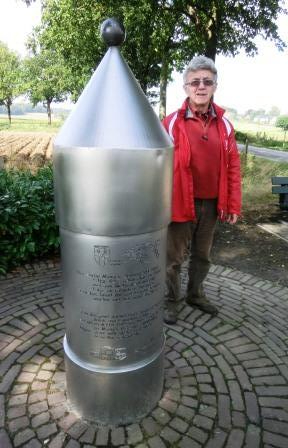
Pieter at the memorial for Operation Veritable in Groesbeek. (Photo credit: Daria Valkenburg)

Close-up view of the text on the memorial for Operation Veritable in Groesbeek. (Photo credit: Pieter Valkenburg)
On our second visit to the Canadian War Cemetery in Groesbeek we were joined by Pieter’s former colleague in the Dutch Foreign Service, Ad Scheepers, and his wife Noor, who live in Groesbeek.

Ad and Noor Scheepers with Pieter by the grave of Cpl Arthur Gaudet. (Photo credit: Daria Valkenburg)
Ad was a fountain of information about the cemetery, and noted that it was along the Liberation Route, which one can take to visit the many monuments and memorials in this part of The Netherlands. The cemetery, on a road called Zeven Heuvelenweg (Seven Hills Way), is the largest war cemetery of the Commonwealth Graves Commission in The Netherlands.
Most of the soldiers buried here fell during the fighting on the Lower Rhine between February 8 and March 26, 1945. It’s called the Canadian War Cemetery and we’d always assumed all of the burials were Canadian, but it’s not true. By number and nationality, the 2,617 soldiers buried here are from:
- 2,399 from Canada
- 267 from Great Britain
- 3 from Belgium
- 2 from Poland
- 2 from Australia
- 1 from New Zealand
- 1 from Russia
- 1 from Yugoslavia
- 1 from The Netherlands
Inscribed on the Groesbeek Memorial in the cemetery are the names of 1,103 soldiers reported missing in action between August 1944 and May 1945. Only a few have been identified since the memorial was put up. Unfortunately, most are still listed as MIA (Missing In Action).
Ad told us he’d read that the Cross of Sacrifice in the cemetery was positioned where it was so it could be clearly seen from Germany, a stone’s throw away from the border. It’s likely true, as one prerequisite that Canadian Officers had in selecting land for the cemetery was to have a view of Germany.
In a Dutch reference we read that construction on the cemetery began in 1945 by six Canadian soldiers. The location of the cemetery, on a hilltop, was chosen by Groesbeek Mayor Grotenhuis van Onstein for its view on the German border from the cemetery. The Cemetery was officially opened on May 4, 1947 by the Dutch Queen Wilhelmina. When the cemetery opened, the headstones were made from wood, as was the Cross of Sacrifice. Later, the headstones were temporarily replaced by metal versions, and beginning in 1950 the headstones and Cross of Sacrifice were replaced by stone designs.

Pieter by the Cross of Sacrifice at the Canadian War Cemetery in Groesbeek. (Photo credit: Daria Valkenburg)
In alphabetical order, here are the known soldiers from PEI that are buried in the cemetery:
- L/Cpl Ralph Schurman BOULTER, North Nova Scotia Highlanders, from West Point
- Pte Lawrence BULGER, North Nova Scotia Highlanders, from Foxley River
- Major John Weston CAMPBELL, North Nova Scotia Highlanders, from Clermont
- Cpl Preston D. CAMPBELL, Algonquin Regiment, from Coleman
- Rifleman William Alfred CANNON, Regina Rifle Regiment, from Pownal
- Cpl Arthur GAUDET, Les Fusiliers Mont-Royal, from Mont Carmel
- Sapper Joseph Edmond HENNEBERY, Corps of Royal Canadian Engineers, from Morrell
- Cpl George Ivan MACKINNON, North Nova Scotia Highlanders, from Mt. Albion
- Cpl Robert Bruce MACNEILLL, North Nova Scotia Highlanders, from Charlottetown
- Pte Barney R. MCGUIGAN, North Shore (New Brunswick) Regiment, born in Souris
- Cpl Stephen A. MCKINNON, Royal Hamilton Light Infantry, from St. Peter’s Bay
- L/Cpl Edward Gabriel PERRY, Argyll & Sutherland Highlanders of Canada (Princess Louise), from St. Nicholas
- Pte John Clifford ROGERS, North Shore (New Brunswick) Regiment, born in Hope River
- Pte Ralph K. SILLIKER, Lake Superior Regiment, from O’Leary
- Sgt Edison Alexander SMITH, North Nova Scotia Highlanders, from West Point
- Pte George Preston SMITH, North Shore Regiment, from Kinkora
- Pte William L. WEATHERBIE, Royal Regiment of Canada, from Charlottetown
Do you have photos or information on any of these soldiers? If you know of other soldiers from PEI, please help the researchers at the Faces to Grave project by sharing that information. Photos and stories can be sent either through their website at http://facestograves.nl/index.html or by email to info@facestograves.nl. Alternatively, you can contact us and we will forward your info for you.
Comments or stories? You can share them by emailing us at memorialtrail@gmail.com, commenting on the blog, or tweet to @researchmemori1.
© Daria Valkenburg
…Want to follow our research?…
If you are reading this posting, but aren’t following our research, you are welcome to do so. Our blog address: https://onthewarmemorialtrail.com/
 4 countries, 6 weeks, 7,000 km – an unforgettable war memorial journey in Europe…. Daria’s book ‘No Soldier Buried Overseas Should Ever Be Forgotten‘ is available in print and e-book formats. Net proceeds of book sales help support research costs and the cost of maintaining this blog. For more information see https://nosoldierforgotten.com/
4 countries, 6 weeks, 7,000 km – an unforgettable war memorial journey in Europe…. Daria’s book ‘No Soldier Buried Overseas Should Ever Be Forgotten‘ is available in print and e-book formats. Net proceeds of book sales help support research costs and the cost of maintaining this blog. For more information see https://nosoldierforgotten.com/
Subscribe to our YouTube Channel: On The War Memorial Trail With Pieter Valkenburg: https://www.youtube.com/channel/UCJ591TyjSheOR-Cb_Gs_5Kw.
Never miss a posting! Subscribe below to have each new story from the war memorial trail delivered to your inbox.









